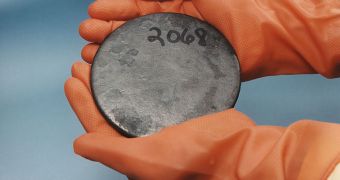In a study that could lead to the development of safer, more advanced nuclear fuels, researchers at the US Department of Energy's (DOE) Los Alamos National Laboratory (LANL) managed to develop advanced uranium compounds. Their achievement was based on advances in uranium chemistry.
Moving forwards in this field of research is very important because it holds the key towards developing new methods of obtaining superconducting materials. Some of these materials can be obtained from uranium, investigators say.
Compounds of uranium can be based on oxygen, nitrogen, halogen, carbon, fluorine, and other elements, and all these substances are potential candidates for creating new and advanced fuels.
The radioactive element has also been determined to be a very efficient catalyst. This is a chemical that either facilitates or slows down a reaction between two other substances, without changing the result.
One of the reasons why progress in this area has been slow is that it's relatively difficult or hazardous to produce uranium starting materials, the solid or liquid chemicals needed to produce uranium compounds. But the LANL team has just removed this limitation.
Experts here were able to develop a way of obtaining uranium starting materials in a safer way than possible before. Details of their work appear in the latest issue of the esteemed scientific journal Organometallics.
The novel method functions at room temperature. It requires uranium to be placed in a mixture containing the liquid organic solvent 1,4-dioxane and the chemical iodine, and eliminates the need to use chlorine-based chemicals or mercury.
“A major barrier to widespread uranium chemistry research has been access to these starting materials. Easy access to uranium(III) and -(IV) precursors can change the way people do uranium work because there is less waste, and it’s simpler, cleaner, safer, and faster,” explains Jaqueline Kiplinger.
“It’s my belief that these developments will open doors to a variety of new uranium research areas,” adds the expert, who was the lead scientist on the new investigation. She is based at the LANL Materials Physics and Applications Division.
The new study was primarily funded by the DOE Office of Science-Heavy Element Chemistry program, the Los Alamos Laboratory Directed Research and Development program, and Los Alamos National Laboratory Director’s and G.T. Seaborg Institute for Transactinium Science Postdoctoral Fellowships.

 14 DAY TRIAL //
14 DAY TRIAL //